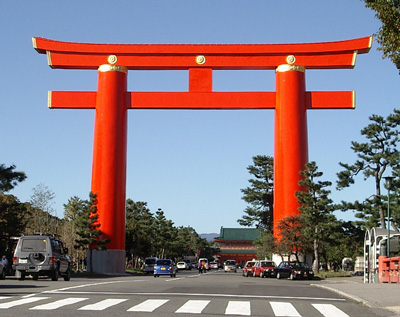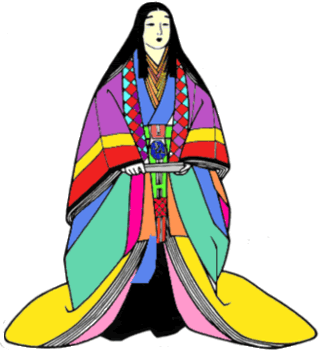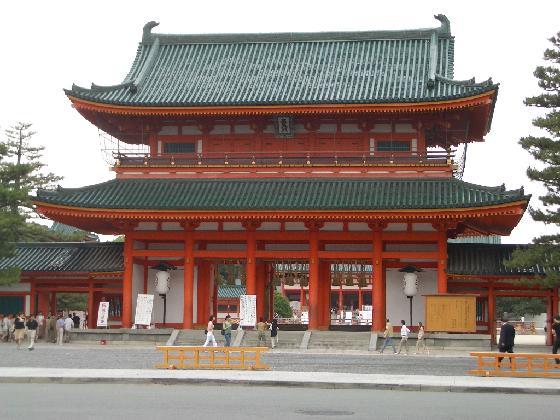
Principal Heian
Literary Texts
Pre-Heian (Nara 710-785)
Kojiki 712
Histories
Nihon shoki 720
First two written works to appear in ancient Japan, then, were not literary texts per se, but rather historical accounts of the founding of the Japanese polity, the earliest form of the state, including Japan's earliest origin myths. China kept immaculate records of its dynasties, so Japanese thought they should, too!
But the very next thing up--the really earliest literary texts, were poetic anthologies:
There were a variety of verse forms represented here, but eventually the dominant one was the 31 syllable waka with its lines divided into 5-7-5-7-7 syllable counts.
Emergence of Waka Poetry - the short, compact verse form rules!
Waka poetry is the very essence of Japanese aesthetic taste, sensibility, of the way the Japanese look at themselves, look at nature, look at the world. And this remained the core of aesthetic values, the expression of aesthetic values, right until recent times. Even today, poets, and others, are influenced by the qualities of classical waka poetry. (Paul Varley)
Heian Poetry785-1185 - The First Imperial Commissioned Poetry Collection
Kokinshu 905 Poetic
Anthology "A Collection of Ancient and Contemporary Poems;"
It's all about minute sensibilities. When are the cherry blossoms going to appear? The spring mist is here. It must mean that spring has come earlier than usual. We should be hearing the cuckoo. Isn't it summer? So that everything, and then talking about love in those terms: "I haven't heard the cuckoo," means, "I haven't gotten a letter from you."
Through poems, courtiers "spoke to each other in a highly allusive, highly suggestive fashion...You never say anything directly. That would be being a brute basically." (Haruo Shirane)
Preface to the KKS by Ki-no-Tsurayuki (see also PDF Ki-Poetics on Wise):
Our native poetry takes the human heart as its seed, and flourishes in the countless leaves of words. People, as they experience the various events of life, give expression to what their minds think, to the meditations of their hearts in terms of what their eyes see, what their ears hear--for all of these they must find words to express themselves. Listening to the nightingale singing amid the blossoms of spring, or to the murmur of frogs among the marshes in autumn--is their any living thing not given to song?
It is poetry which, without exertion, moves heaven and earth, stirs the feelings of gods and spirits invisible to the eye, softens the relations between men and women, calms the heart of fierce warriors, and helps keep order in the world.
Thus, the human heart finds expression in the various modes of speech for its joy in the beauty of flowers, its wonder at the song of birds, its tender welcome of the spring mists, its mournful sympathy with the evanescence of the morning dew.
Ise Monogatari 945 Mixed
Prose and Poetry featuring "headnotes" or explanatory intros:
Tales of Ise consists of 143 episodes, each containing one or more poems and an explanation in the form of a "Headnote" written in prose describing the circumstances of its composition. The brevity and often the ambiguity of the tanka (a five-line fixed-form poem) gave rise to a need for such explanations, and when these explanations became extended or (as in the case of Ise monogatari) were interpreted as biographical information about one poet (Ariwara Narihira), they approached the realm of fiction. At any rate, a clear case of mixing prose with poetry, setting up the poem so it can be more fully appreciated. (See https://www.britannica.com/topic/Tales-of-Ise)
Taketori Monogatari 950 Prose Folktale,
“Tale of the Bamboo Cutter”
Kagero Nikki 974 "Gossamer Years," a Poetic
Diary, by a woman known as the Mother of Michitsuna
Izumi Shikibu Nikki 1004 Poetic Diary of a court lady
Setting the stage for the Triumphant Entry of a massive Prose-Poetry combination which featured a long, sustained prose narrative, one that tells a complex story with a large cast of characters. Waka poetry exchanges are interspersed throughout to heighten the emotional power of many scenes. Some 975 known poems are reproduced in this 1,000+ page text. Nothjing like it had been seen before.
We are talking here about the Genji Monogatari (1010?)
or "Tale of Genji" consisting of 54 “maki” or scrolls byMurasaki Shikibu
It became the compendium for proper behavior, for aesthetic sensibilities. It was kind of like an encyclopedia of culture that poets who were both aristocratic and non-aristocratic looked back to. And when poets composed poetry, they drew the diction from the Tale of Genji, and they also drew their allusions, so if they would talk about some aspect of love, they might make a reference to some episode in the Tale of Genji. (Haruo Shirane)

Sarashina Nikki 1020 Diary by a woman that
mentions reading the Tale of Genji:
I read a few volumes of Genji-monogatari and longed for the rest, but as I was still a stranger here I had no way of finding them. I was all impatience and yearning, and in my mind was always praying that I might read all the books of Genji-monogatari from the very first one.
Eiga Monogatari 1040 A historical account of the Heian Court written by a
woman, Akazome Emon

So the evolutionary trajectory seems to be from poetic anthologies, to mixed prose-poetry texts, and finally to the great Genji followed by lots more types of prose narratives.



